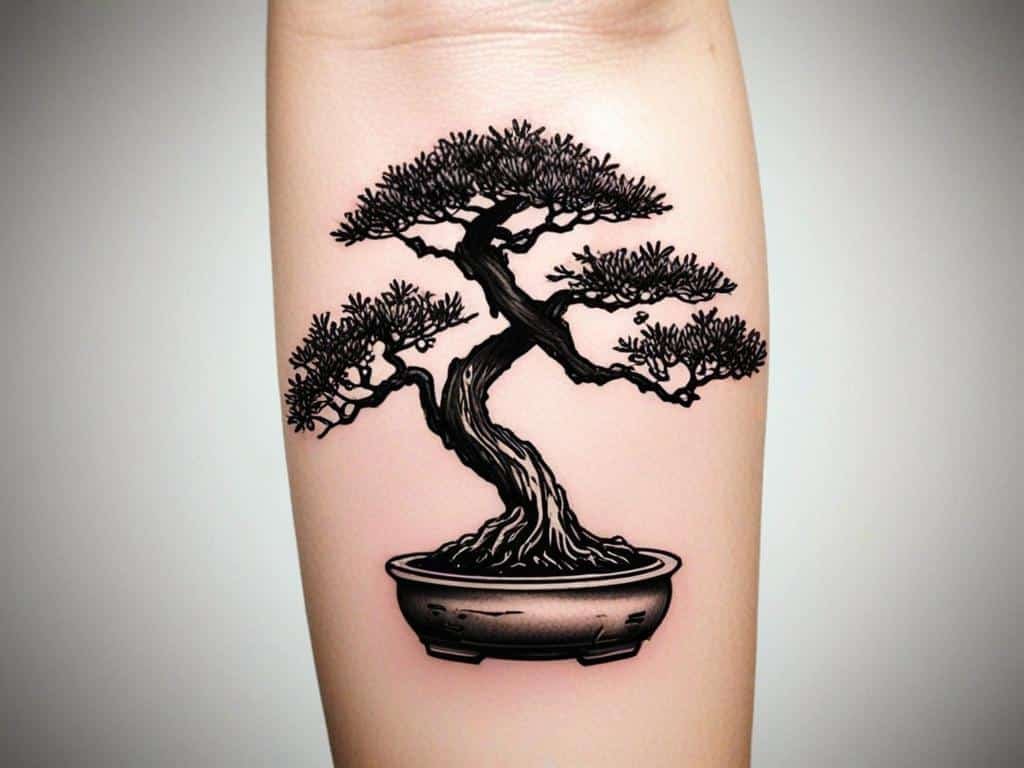Bonsai trees have captivated humans for centuries with there delicate beauty and symbolic meaning. These miniature marvels aren’t just for plant enthusiasts anymore – they’ve made their way into the world of body art. Bonsai tattoos offer a unique blend of nature, patience, and aesthetic appeal that’s hard to beat.
I’ve spent years admiring and researching botanical tattoos, and lemme tell you, bonsai designs stand out from the crowd. They combine Eastern philosophy with artistic expression in a way few other tattoo subjects can manage.
Ready to explore some seriously cool bonsai ink ideas? These designs aren’t your average tree tattoos – each one tells a unique story about balance, perseverance, and natural beauty. Let’s dive into 20 incredible bonsai tattoo concepts that might just inspire your next trip to the tattoo parlor.
1. Traditional Japanese Bonsai
The classic Japanese bonsai tattoo draws directly from centuries of horticultural tradition. These designs typically feature a meticulously shaped pine or juniper with its characteristic twisted trunk and carefully pruned foliage. Artists often incorporate traditional Japanese tattoo elements like wind bars or sakura blossoms to enhance the cultural connection.
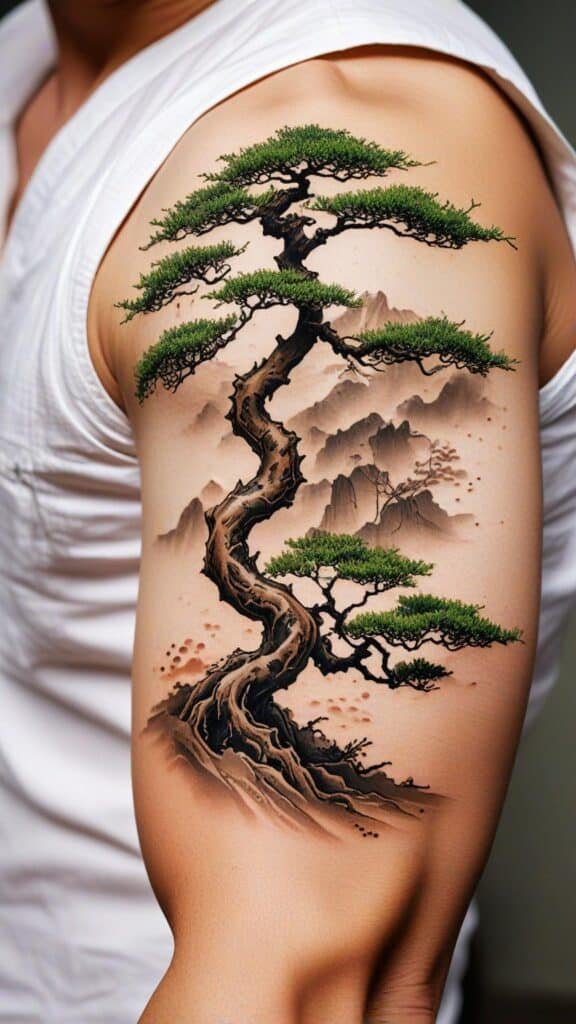
What makes these tattoos special is the attention to detail in the tree’s form. A skilled tattoo artist will emphasize the gnarled branches and textured bark that showcase years of careful training. The roots are usually visible, sometimes draped over a rock or cascading down from a pot, symbolizing stability despite adversity.
For placement, traditional bonsai designs work beautifully as half or full-sleeve pieces where the tree can flow with the natural contours of your arm. The detail and cultural significance of these pieces make them a conversation starter and a meaningful tribute to Japanese artistry.
2. Watercolor Bonsai
Watercolor tattoos have exploded in popularity, and bonsai trees make perfect subjects for this dreamy, fluid style. Instead of crisp lines and solid fills, watercolor bonsai tattoos feature soft edges and translucent color blending that mimics actual watercolor paintings.
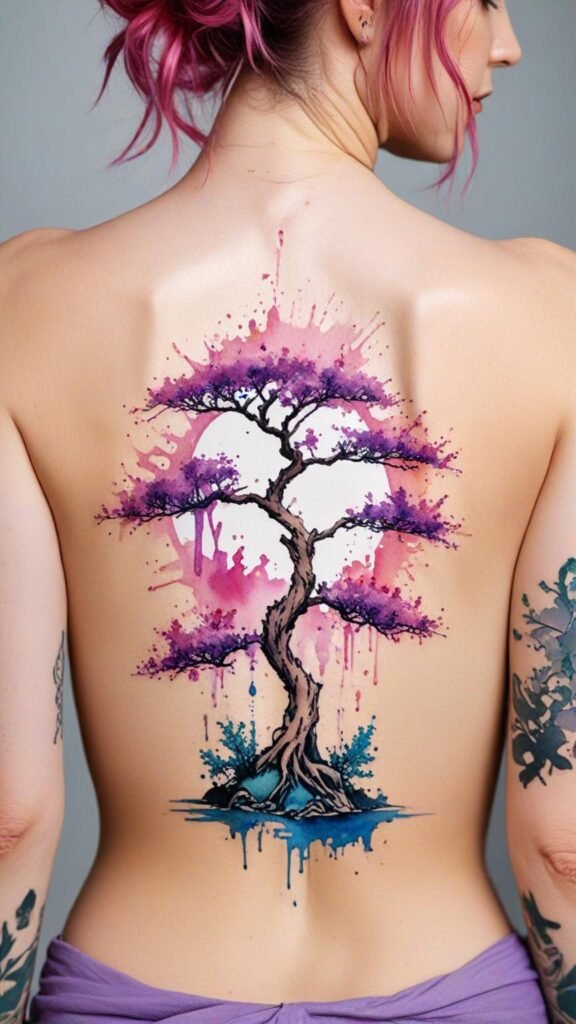
The technique gives these designs an ethereal, almost magical quality. Imagine vibrant splashes of green foliage bleeding into blues and purples, or a trunk rendered in warm browns that fade and blend organically. Artists often add abstract color splatters or drips that seem to float around the tree, enhaning that painterly effect.
These tattoos are perfect for peeps who want something artistic and unique. Keep in mind that watercolor tattoos require special care and may need touch-ups more frequently than traditional styles, but the striking visual impact is worth the maintenance for many enthusiasts.
3. Geometric Bonsai
For those with more contemporary tastes, geometric bonsai tattoos offer a stunning modern interpretation of this ancient art form. These designs break down the bonsai’s organic shape into angular, geometric components – think triangular foliage masses, hexagonal pots, and trunks composed of straight lines and perfect curves.
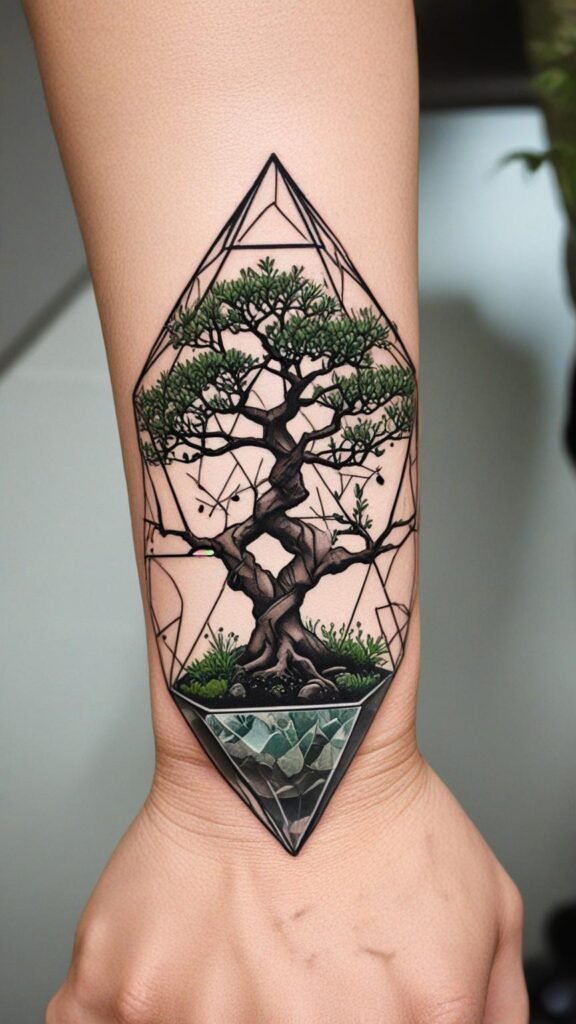
Some geometric bonsai tattoos incorporate sacred geometry patterns like the flower of life behind or within the tree design. Others play with the contrast between rigid geometric shapes and small organic elements, creating a fascinating visual tension.
The precision and mathematical harmony of these designs appeal to folks who appreciate both nature and modern design aesthetics. Geometric bonsai tattoos often look amazing on forearms, upper back, or thigh areas where the design can be displayed in its entirety and appreciated from different angles.
4. Bonsai with Asian Calligraphy
Pairing a bonsai tree with beautiful Asian calligraphy creates a powerfully meaningful tattoo. Japanese or Chinese characters representing concepts like peace, balance, strength, or patience complement the bonsai’s symbolism perfectly and add a layer of personal significance.
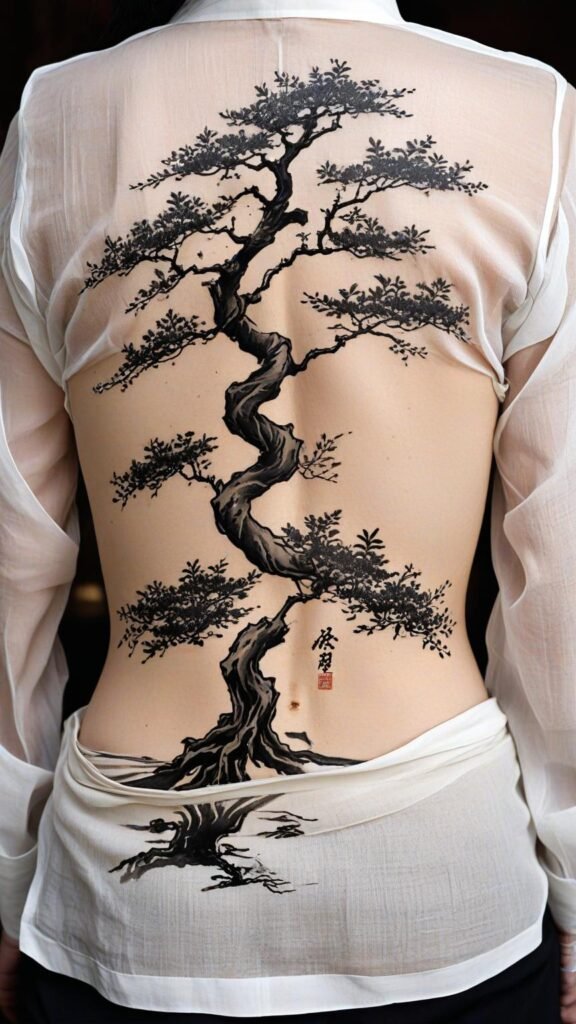
The calligraphy can be incorporated in various ways – flowing along the trunk, positioned below or beside the tree, or even appearing to be carved into the tree itself. Some designs feature the characters as if they’re formed from the branches, creating a seamless integration of text and image.
When considering this style, its absoluteley crucial to work with an artist who understands the language or to consult with a native speaker. Nothing ruins a beautiful tattoo faster than discovering your “inner peace” character actually means “cheap noodles”! These tattoos work well in vertical formats, making them ideal for spine, side body, or leg placements.
5. Bonsai in Circular Frame
Encircling a bonsai design within a perfect circle creates a self-contained microcosm that reflects the bonsai’s nature as a miniature universe. This framing device gives the tattoo a medallion-like quality that draws the eye and creates a sense of completeness.
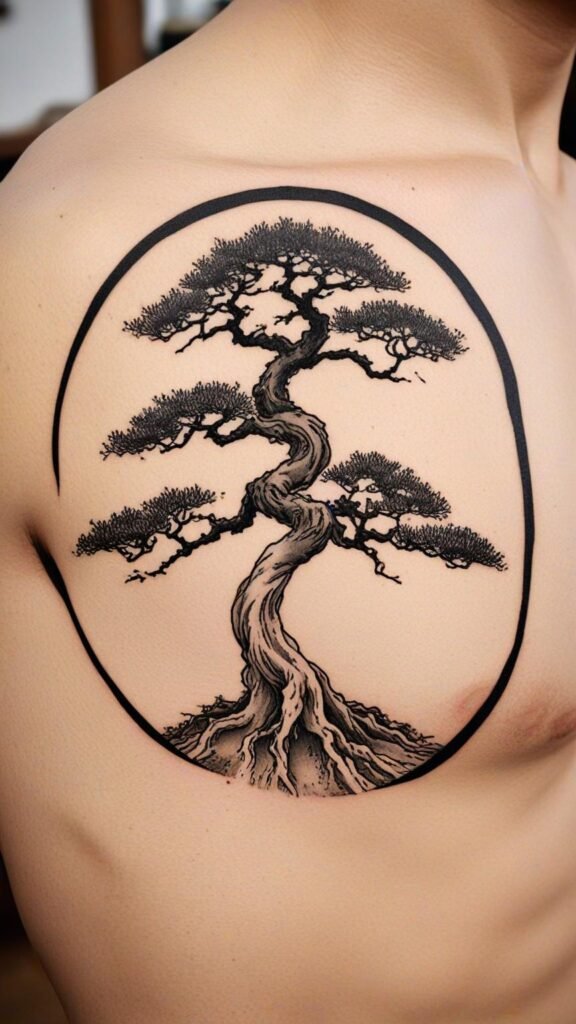
Artists can play with the circle in creative ways. Some designs feature dotwork stippling that fades toward the edges, creating a spotlight effect on the tree. Others incorporate the circle as a window or portal, suggesting a glimpse into another world. The circle might also represent the moon, with the bonsai silhouetted against it.
These tattoos look stunning on flatter body areas such as the upper back, chest, or outer thigh. The circular framing makes them particularly effective as standalone pieces that don’t necessarily need to connect to other tattoos, tho they can certainly be incorporated into larger scenes.
6. Bonsai with Mountain Landscape
Combining a bonsai tree with a misty mountain landscape creates a tattoo that tells a complete story about nature’s grandeur. This style often depicts the bonsai in the foreground with mountains fading into the distance behind it, creating a sense of perspective and depth.
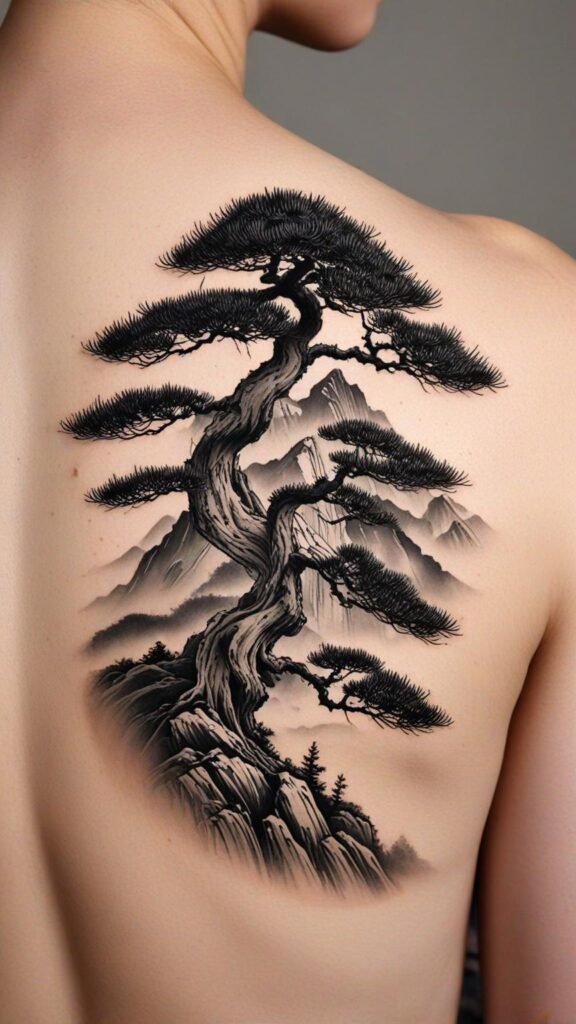
The juxtaposition of the tiny, cultivated bonsai against wild, massive mountains creates a philosophical contrast between human intervention and untamed wilderness. Some designs play with scale by making the bonsai appear to be a full-sized tree within a vast landscape, blurring the line between miniature and massive.
These scene-based tattoos require more space and work particularly well across the upper or lower back, chest, or as sleeve pieces. The level of detail can be adjusted based on size, with larger pieces allowing for intricate mountain ranges and atmospheric effects like fog or clouds.
7. Bonsai and Animal Companions
Incorporating animals into bonsai tattoo designs adds narrative and symbolism to the piece. Birds perched on branches, deer resting beneath the tree, or koi fish swimming around exposed roots create dynamic compositions that bring the static tree to life.
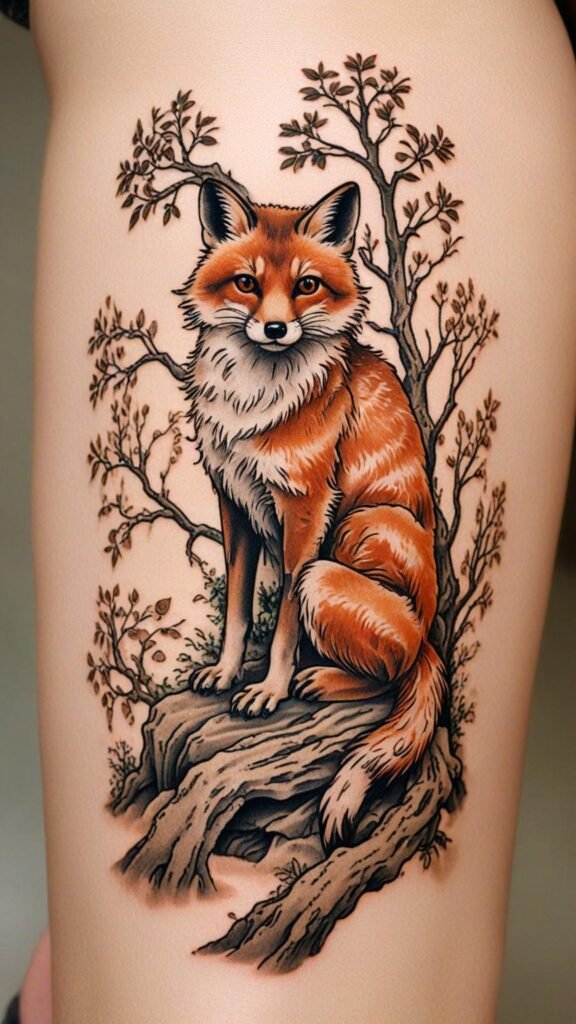
Each animal brings its own symbolic meaning. Cranes represent longevity, wolves signify wilderness and freedom, while butterflies symbolize transformation. The animal you choose can personalize the tattoo to reflect your own spiritual connections or personal characteristics.
The inclusion of wildlife also provides opportunities for contrasting textures – the rough bark against smooth feathers or fur creates visual interest. This style works well in larger formats where the detail of both tree and animal can be fully realized, making them ideal for back pieces, chest tattoos, or full sleeves.
8. Abstract and Surreal Bonsai
Breaking free from botanical accuracy, abstract bonsai tattoos play with surreal elements to create thought-provoking body art. These might feature impossible branch configurations, color schemes that defy nature, or integration with non-botanical elements like mechanical parts or human anatomy.
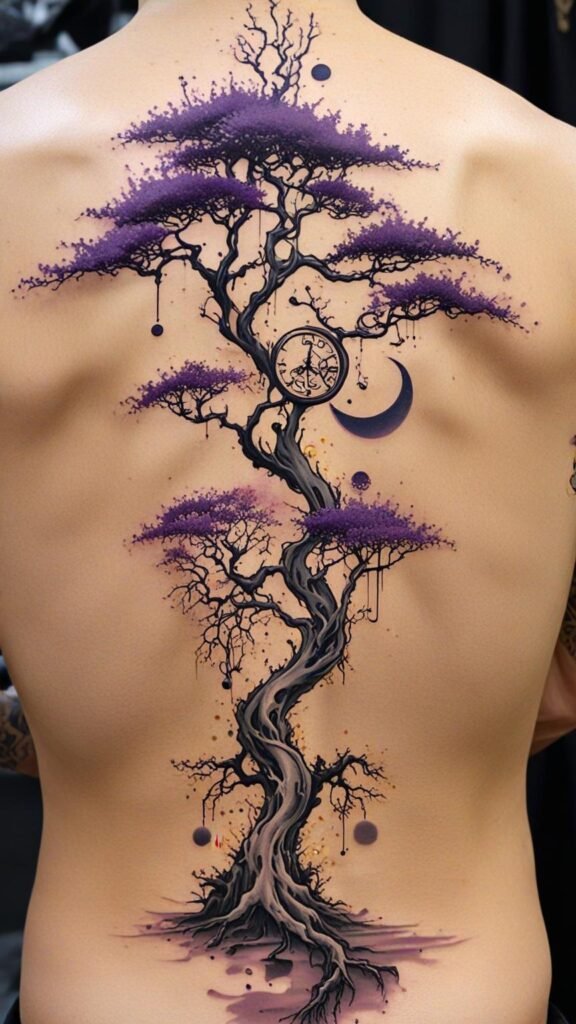
Some surreal designs show the bonsai growing from unexpected sources – emerging from a human heart, sprouting from a brain, or rising from broken stone. Others might invert the traditional growth pattern, with roots reaching skyward and branches digging into earth, symbolizing a reversal of natural order.
These unconventional designs appeal to creative personalities who value artistic expression over traditional symbolism. The abstract nature of these tattoos means they’re highly adaptable to different body locations and can be scaled up or down while maintaining their visual impact.
9. Four Seasons Bonsai
The four seasons bonsai tattoo captures the tree’s appearance throughout the yearly cycle within a single design. Typically divided into quadrants, the tattoo shows the same bonsai in spring bloom, lush summer growth, autumn colors, and bare winter branches.
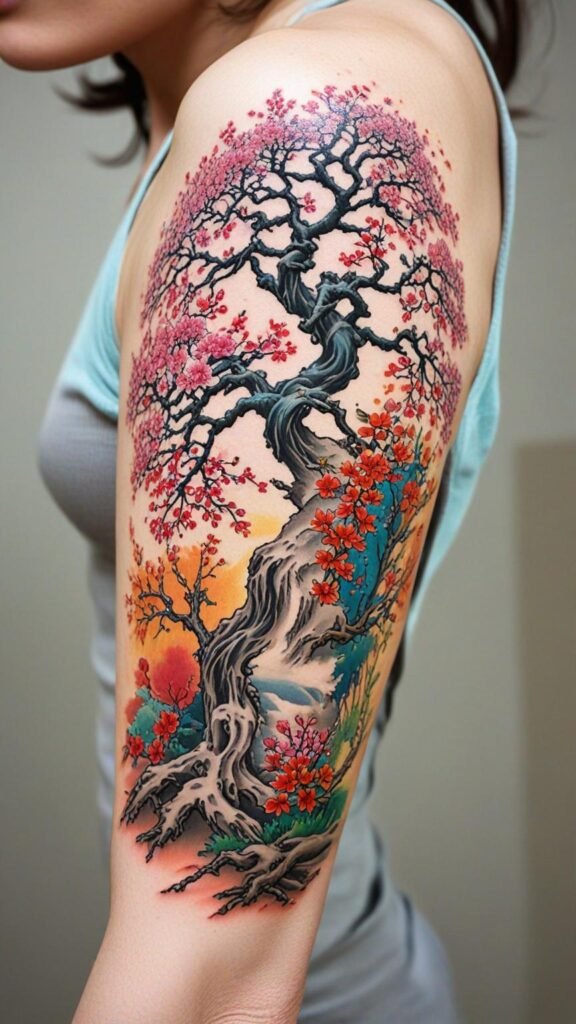
This concept symbolizes the cycle of life, perseverance through change, and the beauty found in each stage of existence. Some designs use color transitions to blend one season into the next, creating a harmonious flow around the tree.
The complexity and detail of these pieces typically require significant space, making them excellent candidates for back pieces, chest covers, or thigh tattoos. The seasonal concept lends itself well to circular formats, though skilled artists can adapt it to work with the body’s natural contours in any location.
10. Minimalist Bonsai Outlines
For those who prefer subtlety over elaborate detail, minimalist bonsai tattoos offer elegant simplicity. These designs reduce the tree to its essential form using clean, continuous lines with minimal shading or color. The result is a sophisticated, understated tribute to the bonsai tradition.
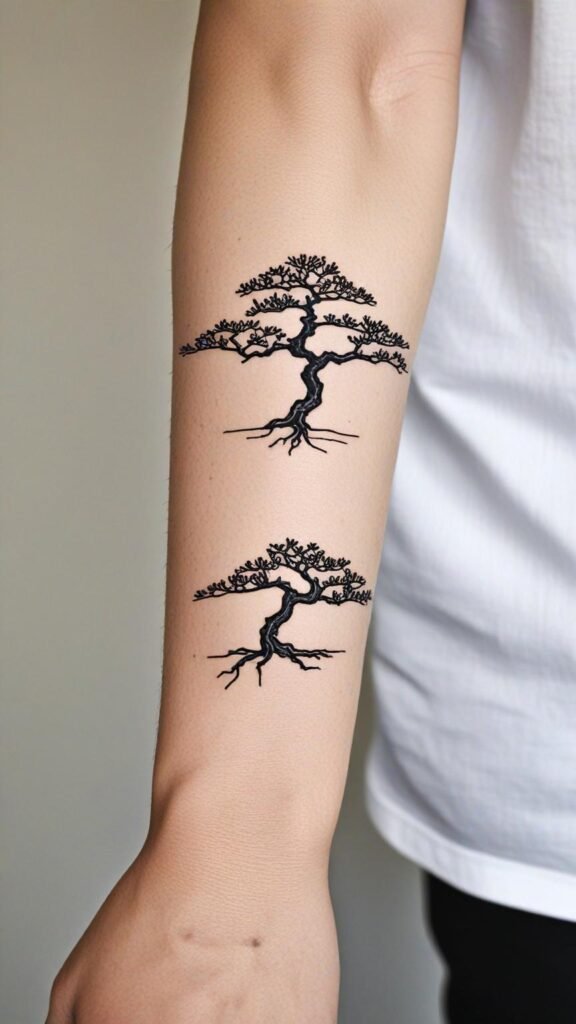
Single-line tattoos, where the entire tree is created without lifting the needle, have become particularly popular. These create a flowing, calligraphic quality that captures the bonsai’s essence with remarkable economy. Some minimalist designs incorporate small touches of color – perhaps a hint of green in the foliage or a red pot – to create subtle visual interest.
These delicate designs work beautifully on wrists, ankles, behind the ear, or along the collarbone. Their simplicity makes them perfect for tattoo beginners or those who need to maintain a more conservative appearance in professional settings while still expressing their appreciation for bonsai artistry.
11. Negative Space Bonsai
Negative space tattoos use your natural skin tone as part of the design, creating striking visual effects. A negative space bonsai might feature solid black branches with the leaves and foliage defined only by untouched skin showing through carefully planned gaps.

This technique creates a bold, graphic look that’s both modern and timeless. Some designs incorporate dotwork shading around the negative space to create depth and dimension, making the tree appear to glow from within.
These tattoos work particularly well on skin with less melanin where the contrast is most visible, and they tend to age exceptionally well since they don’t rely on fine details that might blur over time. Forearms, shoulders, and upper back provide excellent canvases for this dramatic style.
12. Bonsai Breaking Free
Imagine a bonsai that’s literally breaking out of its constraints – branches shattering a pot, roots tearing through limitations, or the entire tree bursting through a geometric shape that tried to contain it. This concept plays with the tension between cultivation and wild nature.
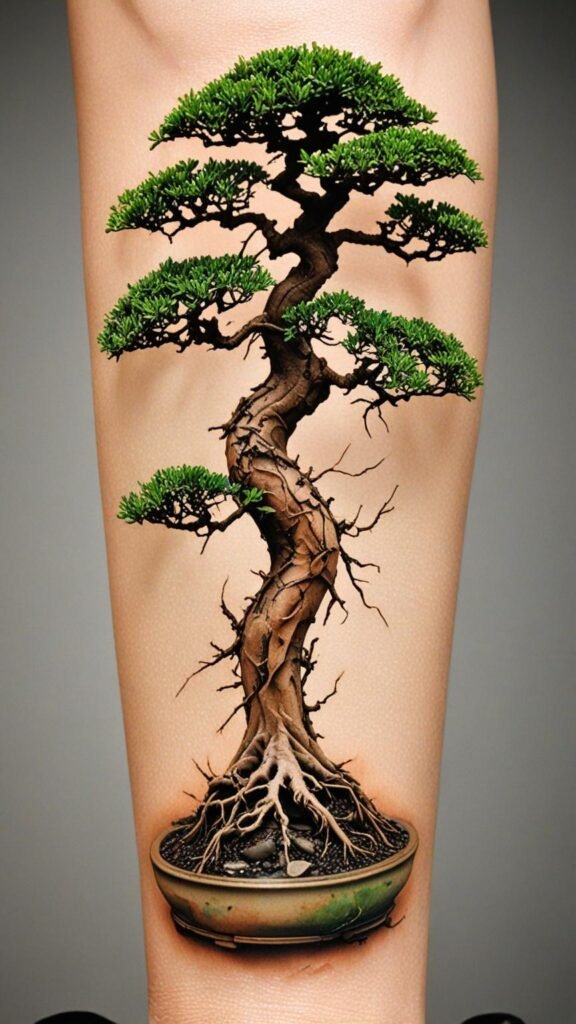
The imagery makes a powerful statement about personal growth, rebellion, and the unstoppable force of authenticity. Artists might emphasize this theme by contrasting precise, controlled elements with chaotic, organic growth patterns.
This symbolic design resonates with anyone who’s ever felt restricted by societal expectations or self-imposed limitations. The dynamic energy of these designs works effectively on areas that flex and move, like the upper arm, side torso, or thigh, enhasing the sense of active breaking free.
13. Starry Night Bonsai
Taking inspiration from Van Gogh’s masterpiece, these tattoos reimagine the bonsai within a swirling cosmic scene. The tree stands as an anchor amidst spiraling stars and celestial bodies, creating a dreamlike juxtaposition of earth and sky.
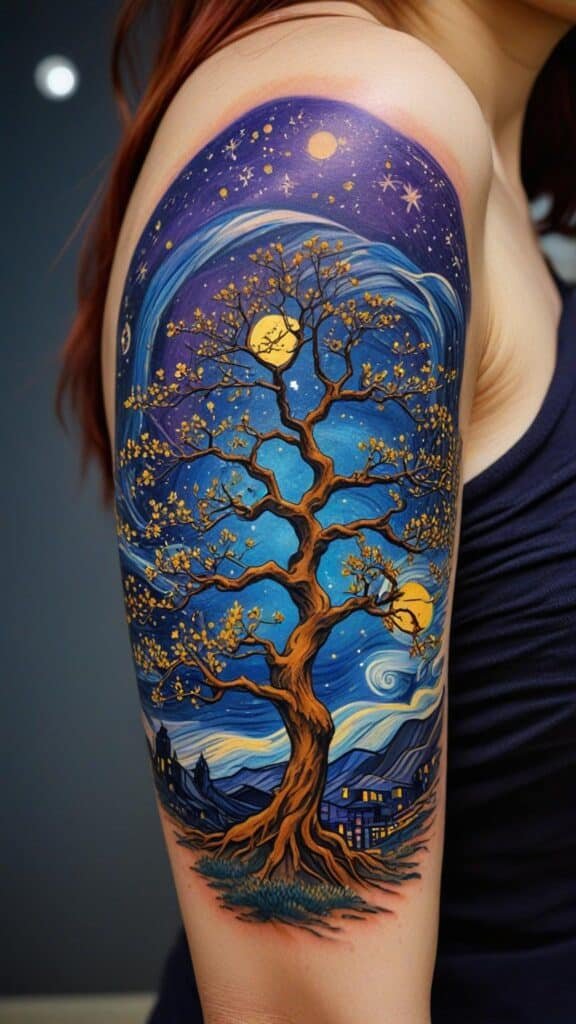
Artists typically use flowing lines and vibrant blues and yellows to capture the painting’s distinctive style. Some versions show the stars and cosmos actually flowing into and becoming part of the tree itself, suggesting a connection between the microcosm of the bonsai and the vastness of the universe.
The result is a stunningly beautiful piece that speaks to the interconnectedness of all things. These somewhat complex designs require adequate space and work exceptionally well across the back, chest, or as a half-sleeve where the swirling elements can flow naturally with body contours.
14. Bonsai as Brain
This conceptual design merges neurological imagery with botanical forms, rendering a bonsai whose branches and root systems mirror the structure of the human brain. The trunk becomes the brain stem, while the spreading branches evoke neural pathways.
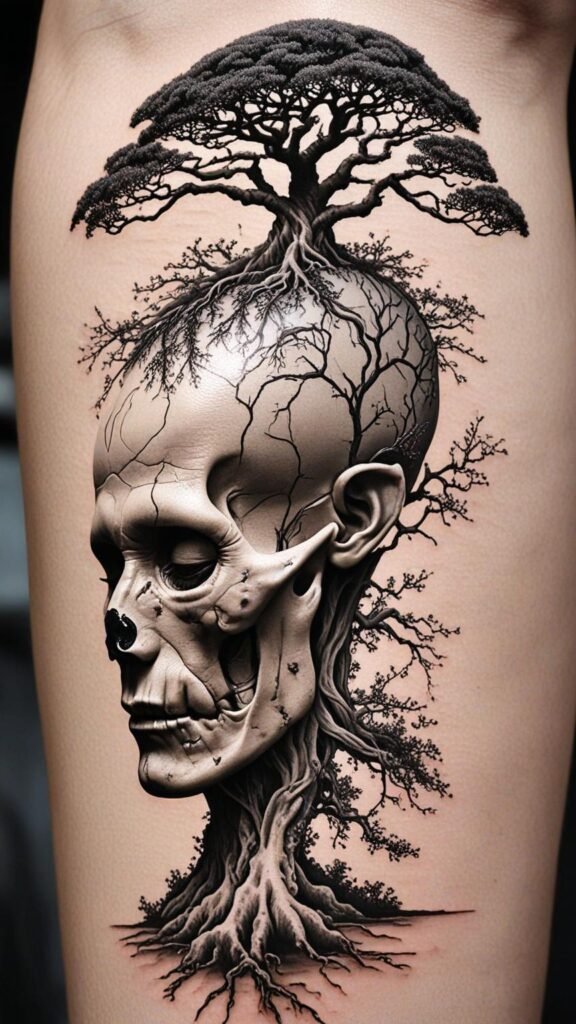
The visual parallel between these growth patterns creates a thought-provoking statement about consciousness, thought cultivation, and the organic nature of cognitive development. Some designs incorporate subtle color transitions from botanical greens to neurological blues and purples.
These pieces appeal to philosophers, scientists, and anyone intrigued by the convergence of nature and consciousness. They’re particularly impactful when placed on the back of the neck (with roots flowing down the spine) or on the upper back where the full neural-botanical network can be appreciated.
15. Bonsai with Japanese Architecture
Combining a bonsai with elements of traditional Japanese architecture – pagodas, torii gates, stone lanterns, or arched bridges – creates a serene landscape tattoo that transports viewers to a peaceful garden sanctuary.
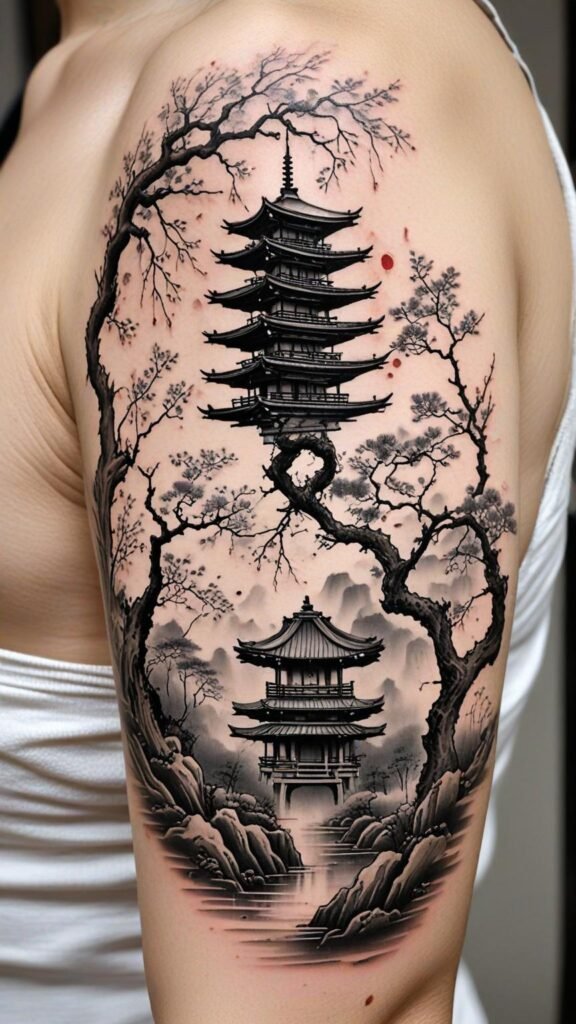
These designs often play with scale, making the architectural elements appear miniaturized alongside the bonsai or creating a distant perspective where the buildings nestle among the branches. Some artists add tiny human figures on the bridges or paths to enhance the sense of story and place.
The combination offers a window into Japanese aesthetic traditions and works beautifully as a larger piece where the architectural details can be fully realized. These tattoos fit naturally as back pieces, chest plates, or full sleeves where the scene can unfold across a generous canvas.
16. Wind-Blown Bonsai
A wind-swept bonsai design captures the dramatic moment of a tree bending but not breaking against powerful elemental forces. The branches and foliage stretch dramatically in one direction, revealing the tree’s resilience and ability to adapt while maintaining its roots.
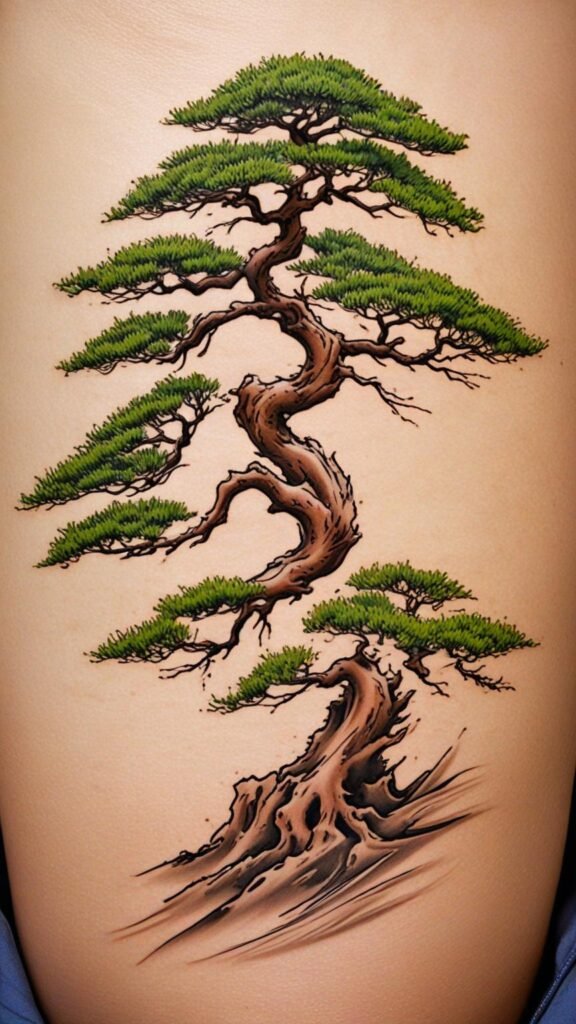
Artists often enhance this dynamic quality with motion lines, scattered leaves, or swirling patterns representing the wind itself. The asymmetrical composition creates visual energy and movement that makes the static tattoo feel alive.
This powerful image resonates with anyone who’s weathered life’s storms while staying grounded. The horizontal flow of these designs makes them ideal for placement across the collarbones, lower back, or as a wrap-around forearm piece where they can follow the body’s natural lines.
17. Bonsai Growing from Unlikely Objects
Imagine a bonsai emerging from an antique pocket watch, an old book, a broken skull, or a cracked geode. These surreal combinations speak to themes of life finding a way, transformation, and beauty emerging from unexpected places.
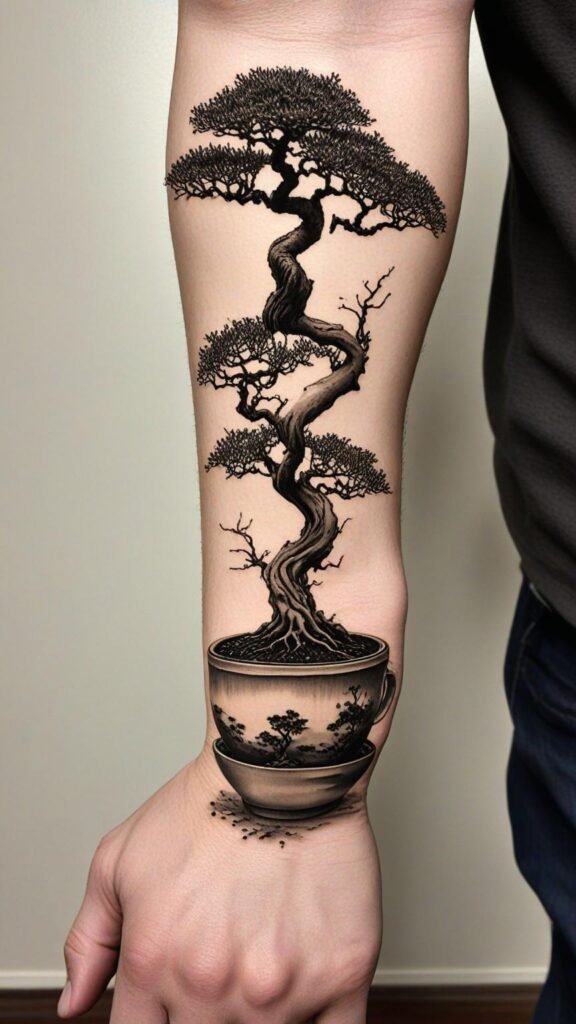
The contrast between the organic, living tree and the inanimate object creates visual tension and storytelling opportunities. Some designs show roots actually wrapping around and incorporating the object, while others depict a more magical emergence.
These conceptual pieces invite viewers to create their own interpretations. The diverse shapes and elements involved make these designs adaptable to various body locations – a watch-and-bonsai might suit a wrist or forearm, while a larger object could work across the back or chest.
18. Bonsai with Elements of Music
Fusing bonsai imagery with musical elements creates a harmonious tattoo that celebrates the artistry common to both disciplines. Musical notes might flow through the branches like leaves, or the tree could grow from a musical instrument like a guitar or piano.
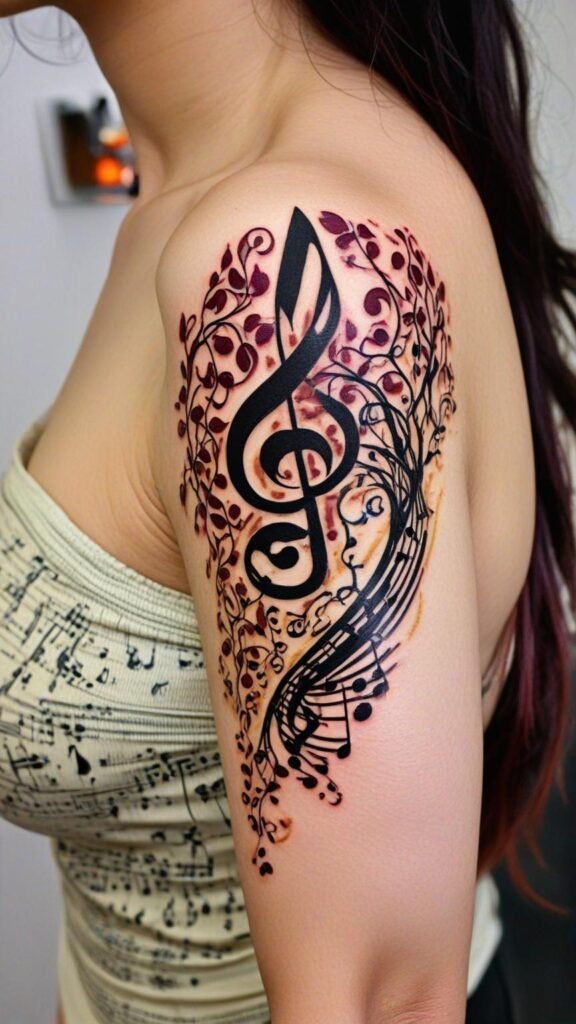
Some designs show the tree’s form echoing sound wave patterns or responding to visible music in the air. The arrangement suggests that both bonsai cultivation and music require similar patience, precision, and creative expression.
This concept speaks to musicians and music lovers who see parallels between natural harmony and musical composition. These designs can be adapted for various sizes, from a small wrist or ankle piece focused on a single bonsai-note motif to larger works that incorporate full instruments and elaborate trees.
19. Bonsai Silhouette with Detailed Interior Scene
This innovative approach presents the bonsai as a silhouette or outline containing a completely different scene inside its boundaries. Within the tree’s form might be a detailed mountain range, an ocean view, a cityscape, or even a galaxy – creating a window into another world.
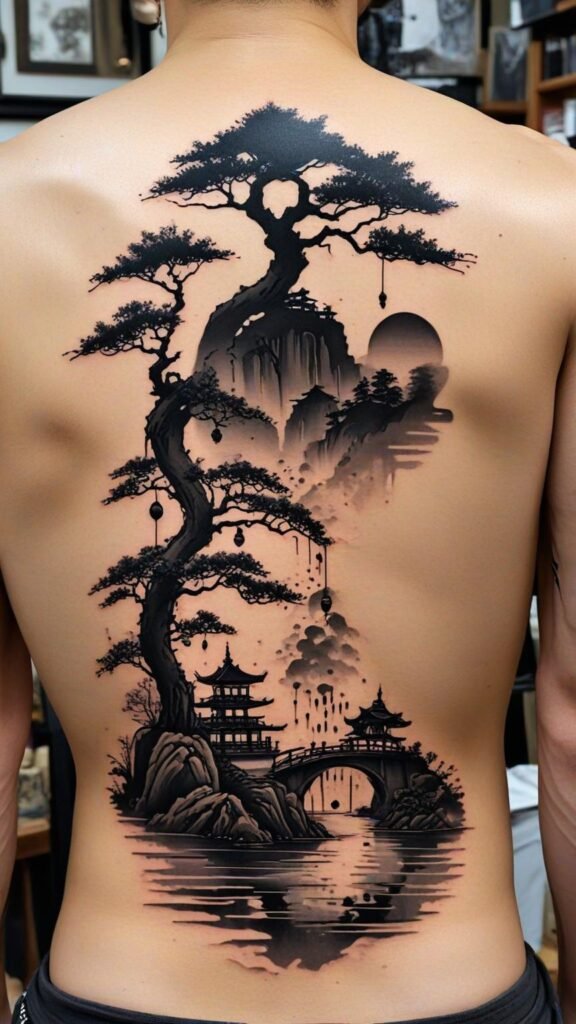
The technique creates a compelling visual paradox, suggesting that the bonsai contains entire universes within its modest form. The stark contrast between the tree’s clean outer lines and the intricate interior scene creates immediate visual impact.
These versatile designs can be scaled to various sizes while maintaining their effectiveness. Smaller versions work well on inner wrists or ankles, while larger renditions with more detailed interior scenes make stunning statement pieces on the back, chest, or outer thigh.
20. Living Bonsai Figure
Perhaps the most imaginative concept transforms the bonsai into a semi-human form, with the trunk becoming a subtle body and branches extending as arms or flowing hair. This anthropomorphic approach creates a forest spirit or dryad-like figure that blends human and tree.
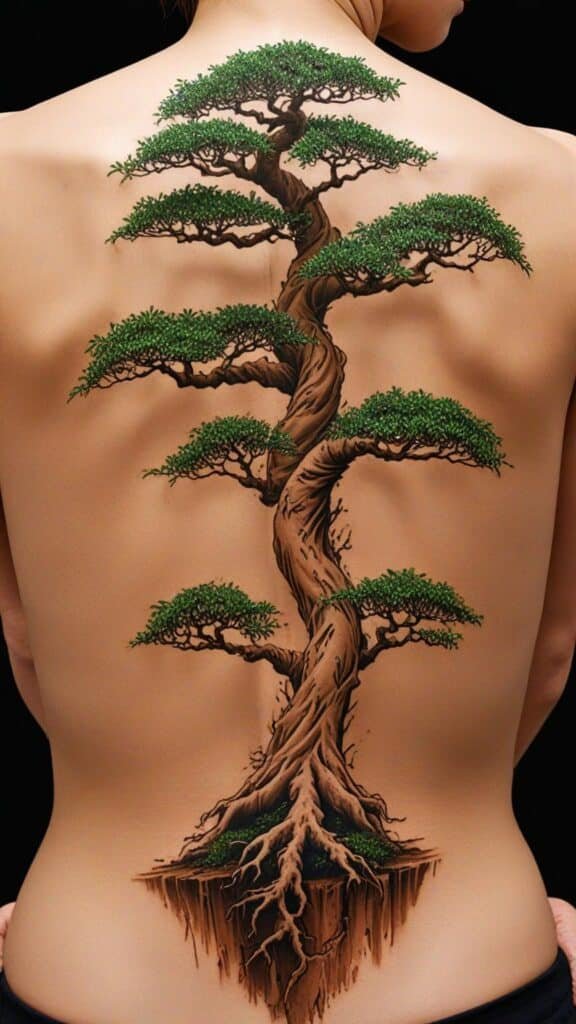
Artists might emphasize the face emerging from bark patterns or keep the humanoid elements subtle enough that viewers need to look twice to see them. The design plays with the ancient myth of humans transforming into trees found in many cultural traditions.
These mystical designs speak to those who feel a deep connection to forests and trees. The vertical orientation works naturally on the spine, sternum, or full calf, where the figure’s proportions can align with human anatomy to enhance the transformative effect.
Symbolism Behind Bonsai Tattoos
Before committing to any bonsai design, it’s worth understanding the deep symbolism these miniature trees carry. In Japanese culture, bonsai represent harmony, balance, and patience. The practice of cultivating bonsai is considered a meditation, reflecting the Buddhist principle of finding peace through mindful activity.
Getting a bonsai tattoo can signify your commitment to personal growth, your ability to weather life’s storms (like the bonsai’s twisted trunk that grows stronger through adversity), or your appreciation for finding beauty in imperfection. Some people choose bonsai tattoos after overcoming significant life challenges, symbolizing how they’ve been shaped by difficult experiences but continue to thrive.
The specific type of bonsai tree adds further layers of meaning. Pine represents longevity and wisdom, maple symbolizes balance and practical thinking, while cherry blossom bonsai embody the transient nature of life due to their short-lived blooms.
Choosing the Right Artist
Finding the right tattoo artist is crucial for a successful bonsai tattoo. Look for someone with a strong portfolio of botanical works, as trees require a specific understanding of organic forms and growth patterns. The best bonsai tattoos demonstrate a knowledge of both tattoo technique and actual bonsai cultivation.
Ask potential artists about their experience with your desired style. A watercolor bonsai requires different skills than a traditional Japanese or geometric interpretation. Don’t hesitate to request a custom design consultation – good artists welcome the opportunity to create something uniquely meaningful.
Remember that quality work deserves fair compensation. Detailed bonsai designs require time and skill, so be prepared to invest accordingly. A well-executed bonsai tattoo will continue to bring joy for decades, making it worth the research and financial commitment to get it right.
Aftercare and Aging Considerations
Like the bonsai trees they depict, these tattoos require proper care to maintain their beauty over time. Fine details in branch structures or delicate leaf patterns may blur slightly as the tattoo ages, so designs with adequate spacing between elements tend to age better.
Be particularly mindful of sun exposure, as UV rays can fade colors and blur lines faster than any other factor. This is especially important for watercolor bonsai tattoos, which may lose their distinctive bleeding edges and color vibrancy without proper protection.
Follow your artists aftercare instructions meticulously, and consider scheduling touch-up sessions every few years to keep your bonsai looking fresh and vibrant. With proper care, your bonsai tattoo will continue to evolve beautifully alongside your own personal growth journey.
Conclusion
Bonsai tattoos offer a remarkable combination of aesthetic beauty and profound symbolism that few other designs can match. Whether you’re drawn to the cultural significance of traditional Japanese styles, the contemporary edge of geometric interpretations, or any of the innovative concepts we’ve explored, there’s a bonsai design that can perfectly express your personal philosophy.
These miniature trees, cultivated with patience and artistic vision, mirror the tattoo process itself – a careful collaboration between nature (your body) and artistic intervention. The result is something uniquely beautiful that continues to grow in meaning over time.
As you consider which bonsai style might become part of your personal story, remember that the best tattoos emerge from thoughtful consideration and clear communication with your chosen artist. Take your time, just as the bonsai master does, and the result will be a tattoo that offers lasting satisfaction and meaning through all of life’s seasons.

Lex memn is a passionate tattoo artist and writer with 3 years of experience in the tattoo world. Dedicated to inspiring and guiding people through creative designs and meaningful tattoo ideas, Lex memn shares their expertise with readers. Explore their work and passion for ink at TifoMags!

